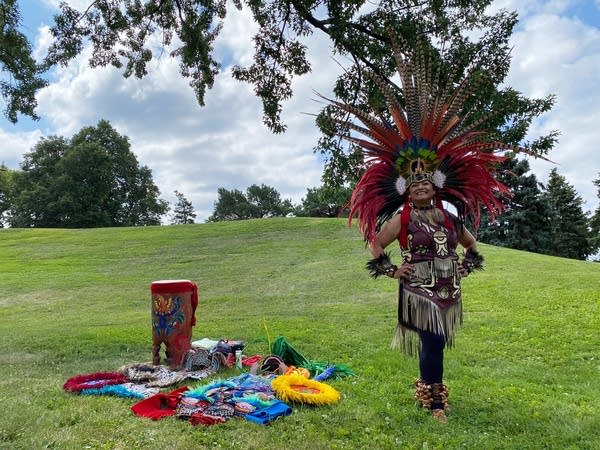‘I have a great responsibility’: Connecting with ancestors through Aztec dance

Go Deeper.
Create an account or log in to save stories.
Like this?
Thanks for liking this story! We have added it to a list of your favorite stories.
Susana De Leon never forgot her mother’s stories.
As a little girl growing up in central Mexico, her mom knew what it was like to suppress her Indigenous roots. She was shamed many times for wearing traditional dresses and having long hair. A family member even took a razor blade to her braids so she could look less Native, cutting her forehead in the process.
What her mother had shed, De Leon has reclaimed: The culture. The dress. The dance.

De Leon, an immigration attorney in Minneapolis, is also a leader of Kalpulli KetzalCoatlicue, a traditional Aztec dance group that has entertained audiences and helped build a sense of community in Minnesota over the past 20 years.
Turn Up Your Support
MPR News helps you turn down the noise and build shared understanding. Turn up your support for this public resource and keep trusted journalism accessible to all.
In 2018, she was named a “general” — a distinction that she says was harder to earn than her law degree. The title holds special significance in the dance tradition.
“That means I have great responsibility to preserve the teachings of our ancestors,” said DeLeon, 55.
Generals are responsible for carrying forward a tradition that is hundreds of years old. Dances are ceremonies that serve to honor and connect with ancestors.

The movements of the dance, already dynamic, can feel even more vibrant with the addition of a dancer’s regalia. Headdresses can be adorned with big, colorful plumage. Anklets provide the rhythm of the dance, and intricately beaded dresses and chest pieces show a dancer’s artistry and skill.
The weight of a dress can be up to 30 pounds, in which case, a dancer might choose a lighter pair of ayoyotes — leather anklets adorned with seed pods or stainless steel bells — to maintain physical balance, but also spiritual balance.
In ceremony, everything has a purpose, including what the dancer wears, what color it is, what symbols are present, what words are spoken, what instrument is used, and what direction the dancer faces, according to De Leon.

At a recent practice at Lake Nokomis, she stands facing east, at the center of a circle of dancers, and draws onlookers in by beating a drum.
“It’s a primordial sound,” she said. “It’s the sound that is contained in our bodies, through our pulse, through our heart.”
The instrument — it’s called a huehuetl — is a hollowed-out tree trunk with animal skin stretched over the top. It represents the ancestors and elders of the community. It doesn’t just keep the beat; it holds the physical and spiritual center of the ceremony.

De Leon started to explore Aztec or Chichimeca dancing as a way to reconnect with lost roots. When she was 19, she immigrated to the United States and later attended the University of Minnesota, majoring in Chicano Studies.

Kalpulli KetzalCoatlicue is a big community. There are about 70 families, totaling 400 people, who cycle in and out of the group. In a normal year, the troupe would be donning regalia and taking the stage at the Minneapolis Monarch Festival this weekend. But like so many events during the pandemic, the festival and performance have gone virtual.
Aztec dance groups exist all throughout North America. There are groups in Houston, Albuquerque, San Jose, and of course, Mexico City.
Being in a community is an important aspect of the kalpulli. Aztec dancing started after Spanish conquistadors invaded the Aztec Empire at Tenochtitlan in 1521. The focus on ancestors is also a way for Latinos to reconnect with the knowledge that was broken by colonization.
De Leon said she understands the importance of bringing people together.
“For the community to have a space where you can come and either connect with the identity that you already have, or an identity that you know, you are part of or an identity that you might have in your past but you're not connected to,” De Leon says, “It's a tremendous blessing and a tremendous healing, [and] I would say radical work that the community has access to.”


